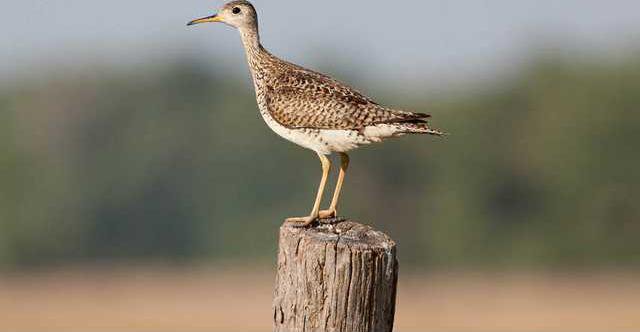We have a special bird in our area at the present time. The upland sandpiper is a beautiful bird. We see them sitting on fence posts. They are very well camouflaged when on the ground. This bird has been called “The Shorebird of the Prairie” since most of it’s relatives are never far from water. This bird thrives on the grasslands. It was previously called the upland plover and Bartram’s Sandpiper after the American naturalist William Bartram (a very interesting fellow — Google him up some time). The bird has been in decline for some time due to loss of habitat. I have seen several of these birds on the roads north and west of the headquarters at the Bottoms-- usually sitting on a fence post.
On another topic, I knew this day would come. I have to print a correction. It is a lot of responsibility to be correct in what you say in a public forum. I have huge and growing respect for the reporters, editors, and contributors to the public outlets and information pathways in America. It also pays royal dividends to have friends who can give you the facts when you make a mistake. My friend, Robert Penner is the avian expert for the Nature Conservancy in our area. I said in the last Musings that the dickcissel was not affected by the drought. I said that because I see them cheerfully singing their little hearts out on the majority of my escapades in the Bottoms and surrounding area. The well-being and survival of the bird populations is a critical issue and a life-long passion for my friend, and there is no room for not being absolutely correct in making statements about birds. Here are the facts about dickcissels and the drought as clarified to me by Robert Penner:
The first line “There are some birds that are less bothered by drought and hot weather in Kansas during the summer” is interesting. I was wondering where you got this information. According the Grassland Bird Surveys that I have conducted on the Preserve for the past 17 years and the nesting success research project be conducted by a Fort Hays State University grad student. The dickcissels have had a huge population decline over the past few years and it would appear that the drought is the main cause of this decline. Last year the researchers found nests in which the eggs basically fried in the nest. With daily temperatures being higher than the temperature of a incubating egg it doesn’t take too many days in a row before the majority of nests begin to fail. If a nest is lucky enough to be successful, the young usually end up starving because the insect population is also very low. Now it is true that dickcissels are wanderers. In other words some years you might have a dense population in a region and the next year very little. Last year Minnesota experienced large numbers of dickcissels, because they most likely moved north because there more southern breeding grounds were just too darn hot and dry. Nearly every species of bird suffers during these hot and dry conditions and the surveys kind of show this. Just thought you might be interested.
I noticed he called my comment “interesting” instead of some other descriptive words that might have been more appropriate.
It is a true pleasure to have smart friends--especially when they live in our area.
Go find a upland sandpiper on a fence post and look at the sheet water that is starting to return to the Bottoms. It restores our faith.
Doc Witt is a retired physician and wildlife enthusiast.
MARSH MUSINGS
Dr. Dan Witt





